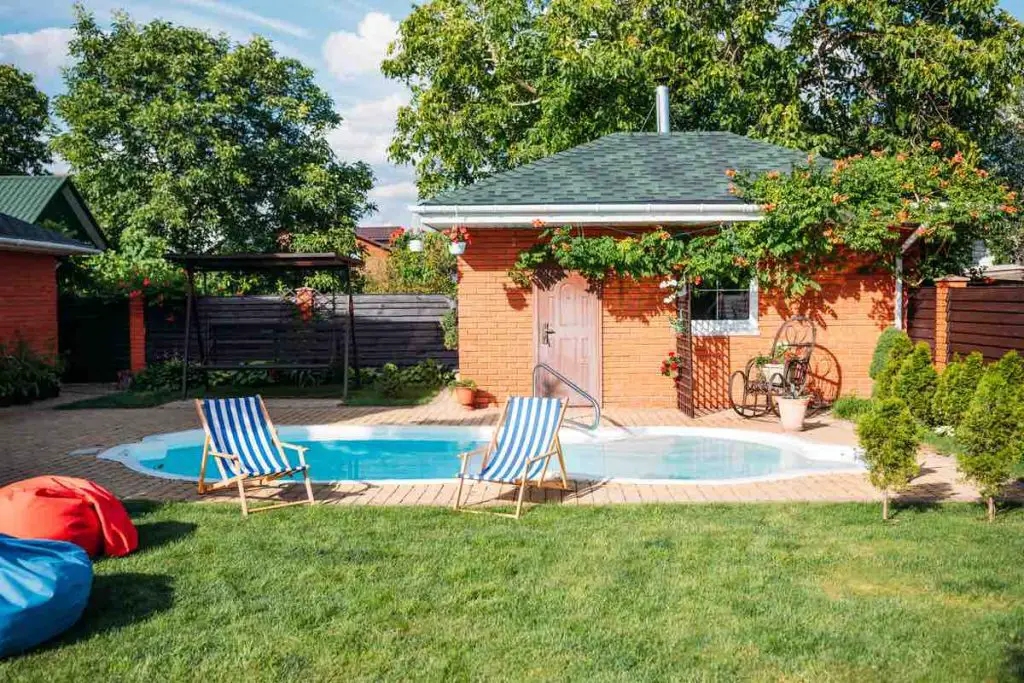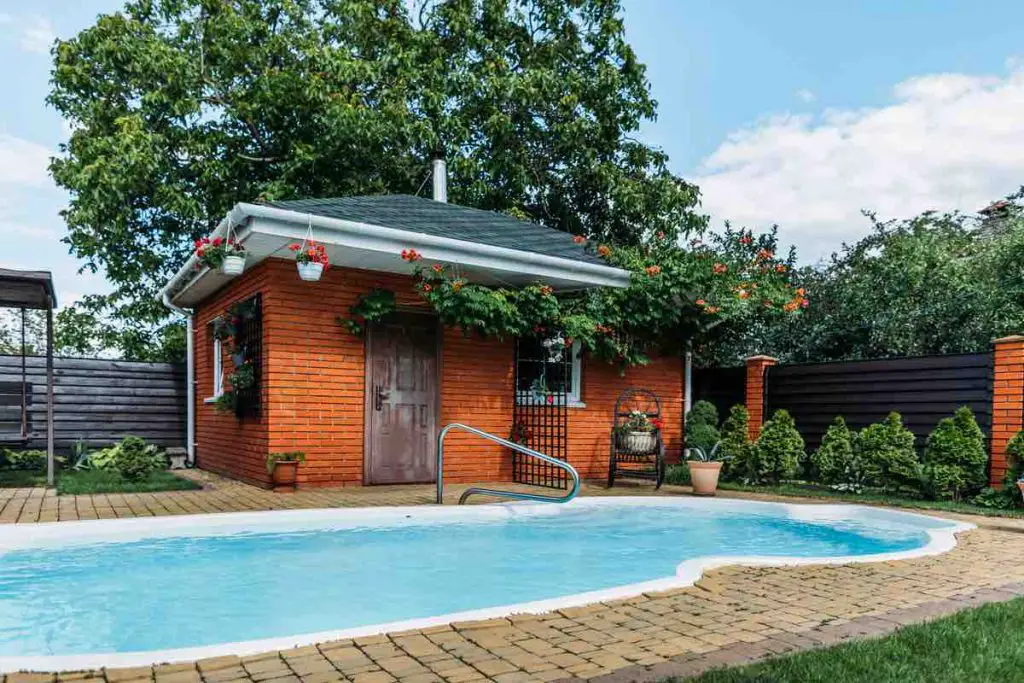When planning the landscape around your pool, you’ll probably want to include plants. However, chlorine is very harmful to plants, so you can’t just choose any without making sure they’ll be able to thrive there.
Some of the plants that can best handle being near chlorine include yucca, aloe, agave, and Mediterranean fan palm, among others. These plants are extremely hardy and resistant to adverse growing conditions, making them perfect for various landscaping applications.
In this article, you’ll learn about these 11 plants and how to use them in your poolside landscaping. They’re all reasonably hardy options, so they handle heat and chlorine without issue.

1. Yucca
Yuccas are a very hardy plant species that give off a tropical vibe, making them perfect for growing near your pool. They can handle various light conditions, including full sun and partial shade, so you can include them in many different landscaping designs.
While their root systems are robust, they aren’t invasive. You won’t have to worry about them interfering with the structure of your pool or home.
These trees are also straightforward to take care of. Ensure you provide them with ample water and drainage until they become more established. Outside of this initial phase, they don’t require very much care.
Overall, yucca plants are perfect for use around your pool. The trees can offer more privacy with their full, spiky leaves and help give your pool a tropical feeling.
2. Aloe
Next, you’ll want to consider planting aloe around your pool. These plants are also extremely hardy and don’t need much water once established. However, they won’t offer you much privacy because they’re close to the ground. Because of this, you can use them in the first layer of plants around your pool to add more greenery to your space.
Aloe also has some medicinal properties; it’s particularly helpful when it comes to healing sunburn. All you need to do is cut the plant open and squeeze out some of the gel before applying it to your skin. Many pool owners find this convenient.
Aloe resists chlorine well, as long as you don’t pour water from the pool over them. You can get the plants to last a very long time outside.
3. Agave
Agave plants are also very durable. They can resist drought and cold temperatures and can thrive beside swimming pools. You can plant them in pots around the pool or stick them directly in the ground, making them very versatile for decorating.
Leaving them out of a container will cause them to produce more flowers. You can browse through tons of varieties of agave, including the following:
- Fox tail agave
- Tuxedo agave
- Butterfly agave
- Queen Victoria agave
If you enjoy succulents, you’re sure to love these plants. They have smooth, long leaves that can look stunning in any setting.
4. Mediterranean Fan Palm
The Mediterranean fan palm is highly durable. It can grow in dry, low-nutrient soil and is very drought-resistant. The fan palm also won’t be phased by the presence of chlorine on the property.
These trees make the perfect poolside focal point. Plus, they won’t drop much foliage into the water. They grow very slowly, so you won’t have to prune them often. In short, they’re hardy and easy to care for.
5. Willow Oak
Willow oaks can provide you with ample shade and privacy around a pool. The willow oak can even tolerate pollution, so chlorine also shouldn’t be a problem for it.
You’ll need to plant these trees at least six feet away from the pool so the roots don’t expand underneath it and cause damage. This distance also helps prevent falling leaves from ending up in your pool, so you’ll have less to clean up later.
These trees can become very large, with most growing up to 60 or 70 feet (18 to 21 meters). Overall, willow oaks are one of the best trees to plant near a pool, as long as you have enough space for one.
6. Creeping Rosemary
Creeping rosemary is a vine, so many people prefer to grow them on a trellis near the pool. They’ll also easily take to a wall or fence while filling your space with a pleasant scent. They’re even well-suited to be around open swimming pools because they don’t produce a lot of litter.
The vine also thrives in full sun, meaning you won’t have to worry if there are no shady areas around your pool to plant them in. Creeping rosemary also won’t mind any chlorine that wafts over to it.
7. Lithops
Lithops are succulents that do very well in full sun. They come from arid regions, so they grow best when you don’t overwater them. You only need to moisten their soil occasionally during the summer months and not at all during the winter.
These plants are tiny but colorful and fun, making them appealing for the poolside. Like many other succulents, they’re incredibly hardy, so being near chlorine won’t harm them.
8. Maiden Grass
Maiden grass is ornamental grass that can resist chlorine. Many people plant it among well-spaced shrubbery to help certain areas appear full and green. The grass is very easy to care for and can make your other plants look better. It can get quite tall, so it’s best to keep it in the back of your pool garden.
You can easily combine maiden grass with all the other plants on this list. Plus, maiden grass repels bugs, making it ideal for keeping away mosquitoes.
9. Oleander
Oleanders also grow well beside pools. These large bushes can provide shade, are pretty easy to take care of, and don’t require much maintenance. Overall, they tolerate chlorine well, so you can get them to thrive poolside.
However, you shouldn’t plant oleander on your property if you have pets or young children. The plant is very toxic, and the leaves can make small animals and kids sick. It can even be dangerous to adults, so you’ll want to be very careful with them.
Still, many gardeners love having oleander beside their pools; the plant is very hardy and produces beautiful blooms that you can find in many colors. Before planting oleander, you’ll want to ensure you know how to handle it properly.

Sources
- Insider: Aloe Vera for Sunburn: Why It Works and How To Use It
- Gardening Know How: Willow Oak Tree Information: Learn About Willow Oak Tree Care
- Succulent Gardens: Lithops
- Gardening Know How: Oleander In The Landscape – What Parts of Oleander Are Toxic
- S.R. Smith: Best Chlorine Tolerant Plants
- Gardening Know How: Poolside Gardens – What Are Some Poolside Plants
- Garden Guides: Chlorine Tolerant Plants
- Walkers Palms: Yuccas
- Premier Pools & Spas: Low Maintenance Pool Landscaping Plants To Have Around
- Moon Valley Nurseries: THE BEST SMALL PALM TREES TO ELEVATE YOUR POOL LANDSCAPING
- Gardening Calendar: Maiden Grass: How To Care For And Use Miscanthus sinensis
